The universe contains several billions of billions of galaxies, although less than half of the normal matter in the universe makes up for these structures - which leaves us with half of the mass of normal matter missing. University of Colorado researchers reveal that they have found about half of the missing normal matter in the intergalactic space between galaxies in the local universe. Intergalactic space, or medium, permeates all space from outside the Milky Way to the outermost regions of the visible universe and probably beyond it as well.
Now the question is, where is this entire local missing matter, and what kind of properties does it have? "We think we are seeing the strands of a web-like structure that forms the backbone of the universe. What we are confirming in detail is that intergalactic space, which intuitively might seem to be empty, is in fact the reservoir for most of the normal, baryonic matter in the universe", said Professor Mike Shull from the University of Colorado.
The first observation reporting the finding of hot portions of missing matter in the local universe was made almost one decade ago by Todd Tripp who used a spectroscopic method of quasar light filtered through intergalactic gas in the line of sight.
Most of the missing matter is thought to be composed of baryons, subatomic particles making up normal matter, protons, neutrons, electrons and so on. Shull, along with his colleagues, started looking for baryonic matter by observing the light emitted from quasars - objects of great mass having massive black holes in their cores - filtered through the cosmic webs, which seems to permeate all the space between galaxies, connecting them with one another.
With the help of the Space Telescope Imaging Spectrograph instrument on board NASA's Hubble Space Telescope and the Far Ultraviolet Spectroscopic Explorer, the researchers revealed hot gases that could be used to create a three-dimensional map of the intergalactic space. The signatures seem to belong to oxygen and hydrogen gases, which are superimposed on the light emitted from the quasar.
Out of the 650 cosmic filaments containing hydrogen gas, 83 were also found to contain highly ionized oxygen, believed to be a sign of the presence of large quantities of hot ionized hydrogen, too hot to be seen in visible light and too cool to appear in the X-ray spectrum, which would explain why it has so far escaped detection.
The oxygen probably originated from supernova explosions and spread into interstellar and intergalactic space, only to be mixed with hydrogen and heated to very high temperatures. According to the researching team, 20 percent of the normal matter in the universe can be found in the intergalactic space between these cosmic filaments.
Researchers from the University of Colorado said that over time, this matter could create dwarf galaxies, stars and galaxies.
The next step in investigating cosmic filaments and the missing matter in the universe will be the installation of the Cosmic Origins Spectrograph instrument built by the University of Colorado in collaboration with Ball Aerospace & Technologies Corp. on board the Hubble Space Telescope during the scheduled servicing mission in the third quarter of this year.
"COS will allow us to make more robust and more detailed core samples of the cosmic web. We predict that COS will find considerably more of the missing baryonic matter in weaker filaments. Our goal is to confirm the existence of the cosmic web by mapping its structure, measuring the amount of heavy metals found in it, and measuring its temperature. Studying the cosmic web gives us information on how galaxies built up over time", said Shull.
The COS instrument could help the University of Colorado team investigate more than 10,000 hydrogen filaments, most of which are rich in heavy elements, remnants from some of the first stars in the universe.

 14 DAY TRIAL //
14 DAY TRIAL //